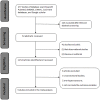Obstructive sleep apnea and the risk of perinatal outcomes: a meta-analysis of cohort studies
- PMID: 25382105
- PMCID: PMC4225536
- DOI: 10.1038/srep06982
Obstructive sleep apnea and the risk of perinatal outcomes: a meta-analysis of cohort studies
Abstract
Inconsistent information exists in the relationship between obstructive sleep apnea (OSA) and perinatal outcomes. This study was intended to investigate whether OSA in pregnant women has a potential to elevate the incidence of the maternal and neonatal outcomes by performing a meta-analysis of all available cohort studies. Five cohort studies including 977 participants were eligible for inclusion. The association between OSA and the risk of perinatal outcomes was expressed as relative risks (RR), with 95% confidence interval (CI). Our results revealed that OSA group was associated with more frequent preeclampsia (RR 1.96; 95% CI 1.34 to 2.86), preterm birth (RR 1.90; 95%CI 1.24 to 2.91), cesarean delivery (RR 1.87; 95% CI 1.52 to 2.29) and neonatal intensive care unit (NICU) (RR 2.65; 95% CI 1.86 to 3.76). On analyzing data for the prevalence of gestational diabetes and small gestational age (SGA) < 10th percentile (RR 1.40; 95% CI 0.62 to 3.19, and RR 0.64; 95%CI 0.33 to1.24, respectively), there were no significant differences in both group. Findings from this meta-analysis indicate that OSA in pregnant women significantly increases the incidence of maternal and neonatal outcomes, which is associated with more frequent preeclampsia, preterm birth, cesarean delivery and NICU admission.
Figures







Similar articles
-
Obstructive sleep apnea screening and perinatal outcomes in Korean pregnant women.Arch Gynecol Obstet. 2013 Mar;287(3):429-33. doi: 10.1007/s00404-012-2602-1. Epub 2012 Oct 21. Arch Gynecol Obstet. 2013. PMID: 23086136
-
Obstructive sleep apnea in pregnancy is associated with adverse maternal outcomes: a national cohort.Sleep Med. 2017 Oct;38:50-57. doi: 10.1016/j.sleep.2017.06.035. Epub 2017 Jul 26. Sleep Med. 2017. PMID: 29031756 Free PMC article.
-
Perinatal outcomes associated with obstructive sleep apnea in obese pregnant women.Obstet Gynecol. 2012 Nov;120(5):1085-92. doi: 10.1097/AOG.0b013e31826eb9d8. Obstet Gynecol. 2012. PMID: 23090526 Free PMC article.
-
The prevalence of obstructive sleep apnea and its association with pregnancy-related health outcomes: a systematic review and meta-analysis.Sleep Breath. 2019 Jun;23(2):399-412. doi: 10.1007/s11325-018-1714-7. Epub 2018 Sep 25. Sleep Breath. 2019. PMID: 30255484
-
A meta-analysis of adverse perinatal outcomes in women with asthma.BJOG. 2011 Oct;118(11):1314-23. doi: 10.1111/j.1471-0528.2011.03055.x. Epub 2011 Jul 13. BJOG. 2011. PMID: 21749633 Review.
Cited by
-
Maternal Snoring May Predict Adverse Pregnancy Outcomes: A Cohort Study in China.PLoS One. 2016 Feb 12;11(2):e0148732. doi: 10.1371/journal.pone.0148732. eCollection 2016. PLoS One. 2016. PMID: 26871434 Free PMC article.
-
Obstructive Sleep Apnea in Pregnancy: Early Lessons From Our Sleep Pregnancy Clinic.WMJ. 2021 Apr;120(1):34-40. WMJ. 2021. PMID: 33974763 Free PMC article.
-
Obstructive Sleep Apnea in Pregnant Women: A Review of Pregnancy Outcomes and an Approach to Management.Anesth Analg. 2018 Nov;127(5):1167-1177. doi: 10.1213/ANE.0000000000003335. Anesth Analg. 2018. PMID: 29649034 Free PMC article. Review.
-
Intermittent Hypoxia Upregulates the Renin and Cd38 mRNAs in Renin-Producing Cells via the Downregulation of miR-203.Int J Mol Sci. 2021 Sep 19;22(18):10127. doi: 10.3390/ijms221810127. Int J Mol Sci. 2021. PMID: 34576290 Free PMC article.
-
Association between sleep problems during pregnancy and postpartum depressive symptoms as well as condition of newborn at delivery.J Obstet Gynaecol Res. 2025 Feb;51(2):e16219. doi: 10.1111/jog.16219. J Obstet Gynaecol Res. 2025. PMID: 39865440 Free PMC article.
References
-
- Young T. et al. The occurrence of sleep-disordered breathing among middle-aged adults. N Engl J Med 328, 1230–1235 (1993). - PubMed
-
- Bradley T. D. & Floras J. S. Obstructive sleep apnoea and its cardiovascular consequences. Lancet 373, 82–93 (2009). - PubMed
-
- Becker H. F. et al. Effect of nasal continuous positive airway pressure treatment on blood pressure in patients with obstructive sleep apnea. Circulation 107, 68–73 (2003). - PubMed
-
- Sahota P. K., Jain S. S. & Dhand R. Sleep disorders in pregnancy. Cur Opin Pulm Med 9, 477–483 (2003). - PubMed
-
- Bixler E. O. et al. Prevalence of sleep-disordered breathing in women: effects of gender. Am J Respir Crit Care Med 163, 608–613 (2001). - PubMed
Publication types
MeSH terms
LinkOut - more resources
Full Text Sources
Other Literature Sources

